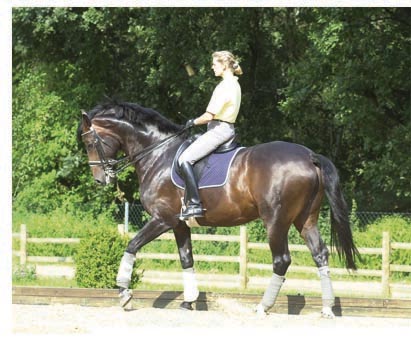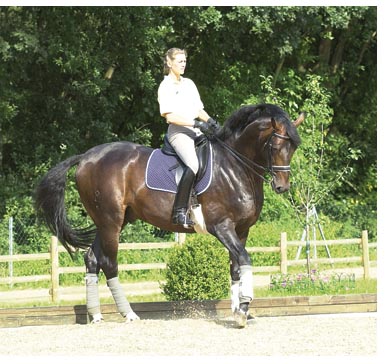WALK
I think walk is the hardest thing because there is no moment of suspension, it is not a swinging gait. Trot and canter go forward. It is like when you ride a motor bike and you have to drive really slow, it is very difficult. It is much easier to go fast and be straight, and it is the same with the walk.
Some horses with a really big walk, you have to keep them fast enough, so they are really 1 – 2 – 3 – 4, with a big walk they can go 1 – 2 and be lateral. They should really go in front of your legs, and you should stay quiet and not try to balance them too much – or then it can become dangerous.
I heard from so many people that you don’t collect young horses in walk when they are three-year-olds. But I always train my three year olds that they have to walk into the hand, round, down, going forward from my leg and into the hand, and work on the bit, so that they know this contact from the beginning. Then you can take them a little bit back – just a little bit – still in front of your leg, and just for a couple of strides – just to look and see if there are problems or not. But the horse really has to go forward from your leg.
If I do feel the horse has gone lateral in the walk, then I do try to help them a little with my reins, so that they feel every step, so that they don’t panic, and they don’t feel hectic. I don’t know if they think about which leg they are using, but I try with my reins to tell them which leg they should use now. Some horses are better in collected walk when you ride them a little bit slower, so they don’t get stressed. Some get tense and that’s when they go a little lateral.

WALK PIROUETTE
This is the same as canter pirouette – you have to think of shoulder fore. Get the horse straight in front of you. Ask him for the bend in the poll, the outside rein is telling the front end to turn around the hind legs. With your outside leg you stop the horse stepping out with his outside leg, and with your inside leg you keep them stepping and the activity behind. With some horses you have to push them a little more with the inside leg and some you have to push more with the outside leg. It is like us, we can’t write with both your left and the right hands. Every horse has its ‘chocolate’ side where everything is much nicer, like the half passes, or the pirouettes, then we don’t have to push so much.
I don’t know why we have to ride walk pirouettes. The judges always seem to give the mark between a 7 and an 8 – I’ve never had a nine for walk pirouette. We have many other interesting movements where you can give a score from a 4 to a 9 or even a 10 – which is better because you can get the horses and riders more separated. I don’t know why we have to ride walk pirouettes any more. They took them out of the Grand Prix and that was a good decision.
If you get a horse that just wants to turn quickly, then at home you train the pirouette bigger – and some they are so slow, it’s hey wakeup, this is a wakeup call!
SIMPLE CHANGE IN WALK
It is the same as we were talking about in the canter entry – the horse has to have the chance to step under. I don’t like the half halts to walk where the horse stops with both hind legs, then there is no flow or rhythm.
Sometimes the horses learn the aids from canter to walk and they start to anticipate it, and do it too quickly, then you can go back and ride canter / trot instead of canter / walk to keep the horse forward. Especially with the older horse, you have to train this transition from canter to trot and trot to canter and the same in walk to canter and canter walk. If the horse is too calm, then I’ll do it faster, and if he is too hot after the canter I’ll let him relax.
I train it always on a turn at the beginning. In a corner or on a volte, not on a straight line.
You can get into problems with the walk if the horse is not strong enough and is not straight enough between your legs – then the horse becomes too lazy behind, and we are in big trouble! When we try to go from the big walk to a little more collected walk, then we get a little tension in the back, and we have a pace, a lateral walk, which we really don’t want. We have to look hard into the horse and wait until it is ready for the walk to be made a little bit smaller.
It is not easy to make a bad walk into a good walk; I have had a few. Some of the Rubinsteins with their big walks were not so easy to collect when we started, but that was because they were too lazy behind and had just been ridden on a long rein. So when I started to collect them, I just had to make them faster from behind and then they went super.
It is very important that the horse accepts your leg, then you can make them faster from behind without making them tense in the back. Ask them to go a little bit faster with the hind legs, but don’t make them tense. That is always the start, that the horse allows itself to be ridden with both legs and to go forward…
More from Martina on her Who’s Who page:




